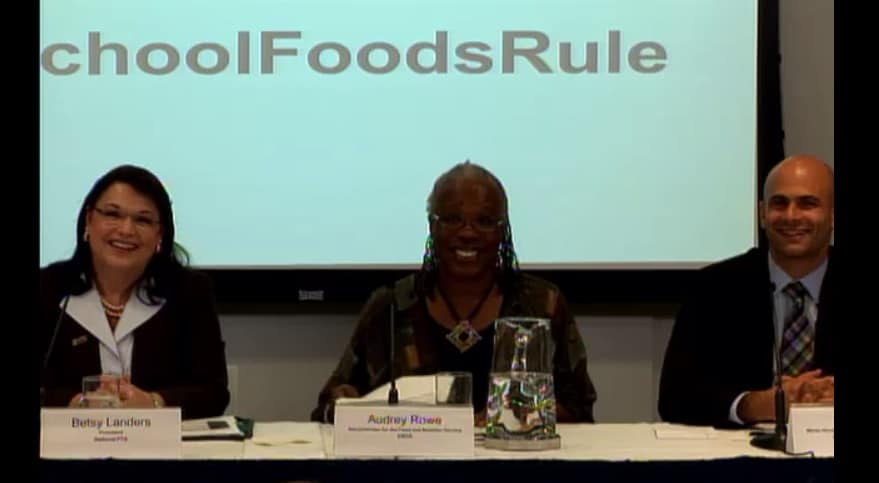On the evening of September 13, 2012, the National PTA, in conjunction with the Pew Charitable Trusts and the USDA, held an online event titled: “Virtual Back to School Night: The School Day Just Got Healthier!” The goal was to provide parents with the a better understanding of the changes to the National School Lunch Program. The event focused on how these new rules will affect the health of the nation’s school children through modifications to the nutrition and caloric content of the foods they consume at school.

White House Chef and Chief Policy Analyst Sam Kass, along with National PTA President Betsy Landers and Audrey Rove, Administrator for the Food and Nutrition Service, answered questions submitted by parents and school nutrition workers via Twitter and in advance by email. Queries spanned topics ranging from what resources were available to schools that needed new equipment or training to comply with the new rules to what school food the panelists remember most fondly from their childhoods.
But in my opinion, the most compelling topic addressed by the panelists centered on ensuring that healthier and more balanced diets within the lunch program isn’t itself viewed a solution to the diet-related health problems from our national suffers. Rather, the changes are best viewed as critical steps toward a goal that can only be achieved through persistent and positive messaging throughout a child’s life. “This is the key to unlocking a healthier future for our country,” according to Kass, whose work with First Lady Michelle Obama’s food initiatives ranges from policy analysis to harvesting vegetables with kids in the White House garden.
So how do we ensure the positive messages kids receive as school lunch programs improve are supported in the next few years? The panel suggested several ideas:
1. Engage kids in the lunch program at school.
Kass explained that when kids feel invested in their lunch program, they’re more likely to use the program, which “reinforces the work school chefs are doing.” Also, the added revenue from increased participation can strengthen the school’s ability to continue to improve the health and taste of the foods they serve. Some schools run a monthly contest to design a day’s menu for the school, which gets kids excited about their role in these healthier offerings. Lunchroom volunteers can be a source of encouragement for kids who are hesitant to try new foods and parents and teachers alike can provide positive reinforcement when kids show they’re open-minded to a healthier diet.
2. Work with your school, but be a source of solutions rather than an identifier of problems.
As parents, you can support your school’s effort to engage kids by offering to volunteer design and construct a school garden, volunteer in the lunch room, or find a group of like-minded staff and community members to develop a wellness policy for your school. According to the PTA’s Betsy Landers parents should “find out what the challenges are and..come up with creative solutions. It’s not enough to just sit back and be concerned.” As an example, the parents of one school district here in Maine have formed their own Food Boosters club to fundraise for new equipment, local agricultural events at the school, and to pay for the hire of consultants and chefs to work with the nutrition staff on the improvements they hope to see. Their proactive stance has virtually eliminated the main objections most schools have to change–cost and additional work–which has drastically improved these parents’ ability to achieve the results they desire.
3. Don’t underestimate your ability to be useful. You don’t need a degree or a chef hat.
One way I’ve been able to educate kids about healthy eating in schools that are resistant to any changes to their nutrition programs is by working with individual teachers and tying a cooking lesson to the existing curriculum. For example, I made corn bread with a class of second graders learning about colonial times; at the same time, students learned a healthy corn bread recipe (and why it was healthier than others) and they went home with a recipe so they could make it for their families. If you have a knack for cooking or even a little extra garden produce you’d be willing to bring in and talk about with a class, you can make a big impact on their nutrition education. Relating the food education to the topics kids are studying is a very effective way of helping them make connections that can help reinforce both topics.
4. Keep it rolling once the kids get home.
To ensure that the positive messages that healthy school meals send will have a lasting impact on our children, we need to make sure they extend to choices made outside of school and within the family. As Sam Kass quipped, “Every time we put a plate of food in front of a child, we’re teaching them,” so your role as home cook is as important as the lessons your children are learning at school. Landers suggested parents request the school’s recipes and prepare similar meals at home to reinforce your child’s positive experience with new ingredients and flavors. Let your kids choose the veggies for a pasta dish that they can help prepare. A little effort can make a big difference to the final effect of a healthier attitude about food.
For more information about how you can help your school’s transition to healthier school lunch standards, you can visit www.healthyschoolfoods.com. Additionally, you can listen to the “School Nutrition: Feeding the Next Generation,” a webinar hosted my me and Guiding Stars’ consulting dietitian Allison J. Stowell, where you can find tons of information and resources about how to support your school’s new challenge.